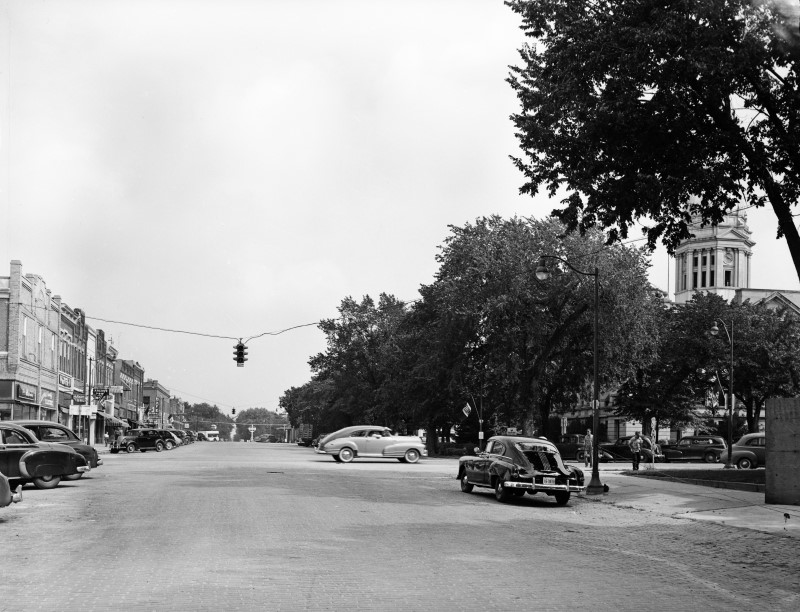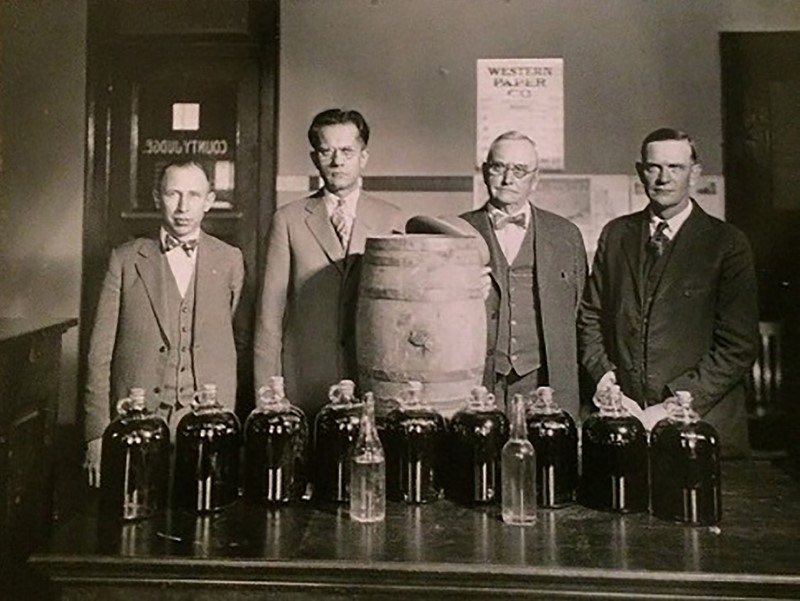Jerrald K. Pfabe’s study of two twentieth-century time periods explores Seward County’s most common forms of crime and examples of each.
By Breanna Fanta, Editorial Assistant
Fifteen-year-old Alby Vajgrt was pregnant, and the family’s farm hand, Anton Lana, was the presumed father. Alby’s family urged that the two get married, but Lana refused and intended to leave.
Two days later his body was found in a shed near the Vajgrt home.
When the Vajgrts were interviewed, Alby and her parents gave contradicting stories. Alby confessed that she had an altercation with Lana, during which a gun accidentally discharged. Her mother shared a similar story. Her father, however, said the sound of gunshots prompted him to run to the shed where he beat Lana in the head.
All three Vajgrts were charged with first degree murder during the preliminary hearing, and the case was forwarded to the district court. After eight days in a packed courtroom and two hours of deliberation, the jury found the Vajgrts not guilty.
This sensational case from October 1923 is one of many uncovered by historian Jerrald K. Pfabe of Concordia University. Pfabe studied Seward County crime, comparing two periods, 1869-1908 and 1919-1948. His recent article in the Spring 2022 issue of Nebraska History Magazine compares the common offenses of both periods and explores the county’s most noteworthy cases.

“Looking north on 6th Street in Seward, 1949. The county courthouse is visible on the right side.” RG2183-1949-815-10
In both periods, larceny, assault, and liquor law violations were the most common offenses.
Larceny was the most frequent crime. In the earlier period horses were often stolen; by the later period it was automobiles.
Chicken theft was once a common crime too. The district court handled seventeen cases, some with multiple defendants, since many chicken thieves worked in teams. In most cases the defendant received up to one year in confinement.
The sentence was usually tougher for repeat offenders such as Harley Klopfenstein, the county’s most prolific chicken thief. Klopfenstein was first tried in 1926 for allegedly stealing 120 chickens over five months. Since it was his first felony, he received sixteen months in Lincoln’s state reformatory. That same day another case was filed against him in which he received the same penalty.
Klopfenstein was charged on two other occasions for chicken theft.
In 1933, when he was charged for stealing fifteen chickens, the community petitioned for leniency. The judge delivered a five-year suspended sentence (similar to probation), but Klopfenstein violated the conditions and consequently received two years in the penitentiary.
Assault was another common crime. While most attacks involved fists, other cases were more violent.
A local family, the Kadavys, hadn’t sent their six children to school because they lacked proper food and clothing. Sheriff Greiner and County Superintendent C. H. Rhoades wanted to arrange some assistance and went to visit the family. But when Greiner approached Frank Kadavy, Kadavy struck the sheriff in the head, breaking his cheekbone.
The following day Greiner returned with the county attorney and Deputy Sheriff William Zeleny, who spoke Kadavy’s native Czech language. When Zeleny entered the home, Kadavy shot him in the thumb. The trio took shelter in a nearby barn, exchanged gunshots with Kadavy, and threw several gas bombs into the house.
Kadavy surrendered hours later when his wife confiscated his guns and ran out of the house. He received a six-month sentence from the country court for resisting authorities and for assault and battery, but he pleaded not guilty in district court to a charge of shooting with intent to kill. After twenty-two hours, the jury was unable to reach a verdict; Kadavy was acquitted in a second trial.
Liquor law violations were a less serious but still frequent crime.
Nebraska went “dry” in 1917, two years before Prohibition began nationwide with the adoption of the Eighteenth Amendment. It remained in effect until 1933. A majority of Seward County liquor law violations involved selling liquor without a license, selling to minors, or sales that were beyond the legal limits.

“Local officials with confiscated liquor.”
“L to R: Paul Bek, County Judge; Stanley Matzke, County Attorney; Newt Scott, Sheriff; Charlie McGraw, Chief of Police, Seward City.” Courtesy of Charles Matzke
Seward County’s most controversial Prohibition-era case involved John Korinek, owner of a general store and town clerk of Bee.
Korinek was selling a patent medicine, Triner’s American Elixir of Bitter Wine, which was said to have an alcohol content of 16 to 18 percent. A state agent arrested Korinek, who admitted that he sold the medicine, but only by the bottle and not for drinking purposes. He explained that there was a demand for it as a laxative, but that no local drug store carried it.
Korinek was found guilty and fined $100 by the local justice of the peace, but the district court dismissed the case.
A Seward Journal editorial said that such medicines should be made available, arguing that if prohibition laws limited medicines in this way, the same standard would have to be applied to other products, such as cooking extracts, that contained alcohol.
Though Seward County was generally tranquil, it saw its share of crime. While examining the records between the two periods reveals some similarities and differences, it also reflects the influence of changes in technology, law, and population trends on small-scale crime.
Pfabe says that “local histories such as this one do not lead to broad interpretations of historical processes. They do, however, shed considerable light on the experiences of ‘ordinary’ people at times different from our own.”
The entire article can be found in the Spring 2022 edition of the Nebraska History Magazine. Members receive four issues per year.



